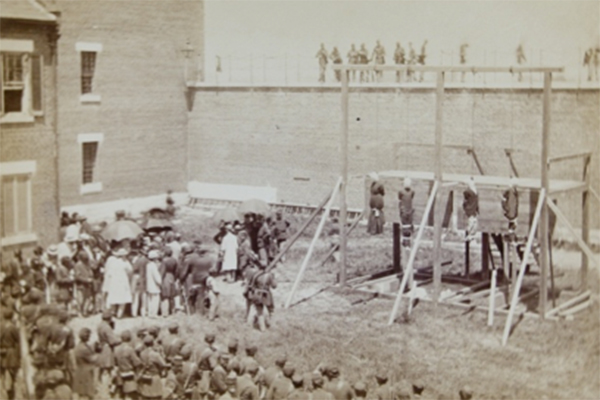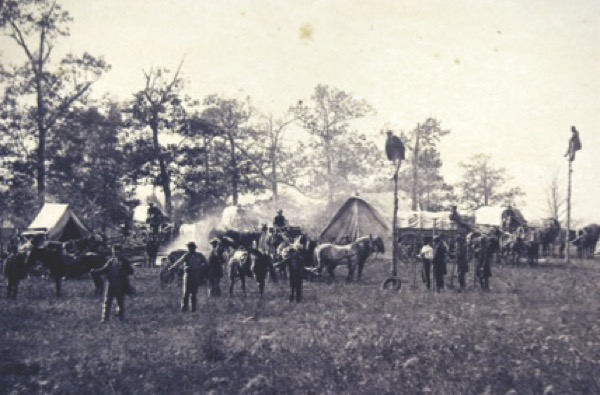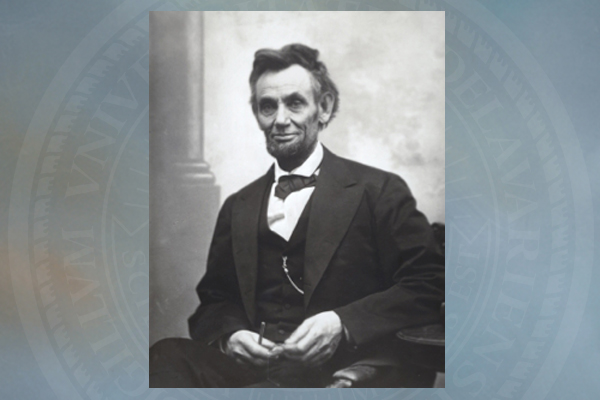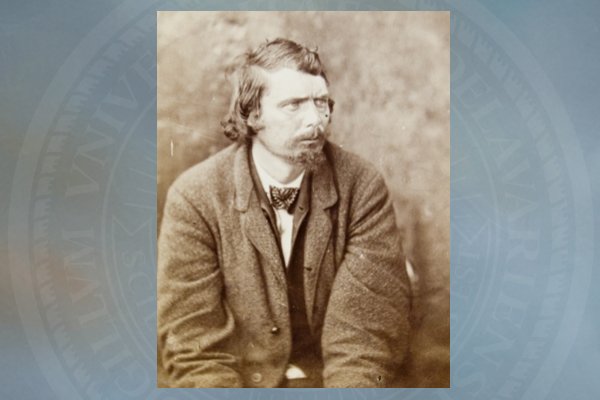


Civil War era photos
Library Digital Collections feature 19th-century Alexander Gardner photographs
8:03 a.m., Feb. 24, 2015--The University of Delaware Library has announced a digital collection featuring nine important photographs by 19th century Scottish-American photographer Alexander Gardner (1821-82).
The Gardner photographs of Lincoln conspirators is comprised of nine images, most of them taken during the execution of four of the conspirators for their roles in the plot to assassinate President Abraham Lincoln.
Campus Stories
From graduates, faculty
Doctoral hooding
Gardner worked for the well-known studio of Mathew B. Brady (circa 1822-96) and is known for his photographs of Lincoln, the American Civil War, and the execution of Lincoln's conspirators. Gardner was the only photographer allowed to photograph the execution of these four conspirators on July 7, 1865.
The start of the Civil War in 1861 increased the demand for portraits of loved ones. For soldiers, sturdy, inexpensive tintypes could be sent home in a letter or carried to the front; delicate ambrotypes in plush cases and albumen prints adorned tabletops in parlors and filled albums.
Brady became well known as a portrait photographer and daguerreotypist with studios in New York and later in Washington, D.C. Studios like Brady’s cropped up in cities across the United States and itinerant photographers offered their services in smaller towns and in military camps.
The Washington studio was frequently visited by Lincoln and the photographer set out to chronicle the Civil War (1861-65).
Brady and his crew of cameramen, carting portable darkrooms, traversed the front lines at great peril to capture every aspect of war: battlefields, ruins, officers and soldiers, corpses, engineering, transport, ships and artillery.
Among Brady’s most powerful images were his photographs of the battlefield dead, which emphasized the gruesomeness of war and the scale of this American tragedy.
By the end of the war, Brady’s studio had produced approximately 7,000 plates.
Gardner taught himself photography and was one of several photographers under Brady’s supervision. Along with Timothy O’Sullivan (later well known for his dramatic photographs of the American West), Gardner left the Brady studio in protest of Brady’s failure to credit his photographers.
Much of Gardner’s work, in fact, had long been attributed to Brady. As Brady’s eyesight failed, Gardner took over more responsibility in the gallery, eventually taking over its operation in 1858 until 1862, when he left to start his own studio.
Brady had displayed photographs by Gardner and James F. Gibson in his New York studio in 1862 in an exhibition titled “The Dead of Antietam.”
Brady’s show received an enormous amount of media attention. Gardner and Gibson’s photographs at Antietam were the first ever taken on a battlefield before the dead had been buried. The New York Times stated, “If he [Brady] has not brought bodies and laid them in our door-yards and along the streets, he has done something very like it.”
Gardner served as the official photographer of the Army of the Potomac. In 1865, he published the important two-volume Gardner’s Photographic Sketch Book of the War, which was included in the 2012 Special Collections exhibition, “In Focus: From Daguerreotype to Digital,” in the Morris Library. Very few photographs in the Sketch Book depicted battlefield dead, documenting the fuller topic of Civil War-era military operations, armaments and camp life.
After Lincoln’s assassination by John Wilkes Booth on April 14, 1865, eight people were tried on charges of conspiracy by a military commission. During the seven-week trial, the prisoners were held at Old Arsenal Prison in Washington.
On July 5, 1865, Lewis Powell (also known as Lewis Paine), Mary Surratt, David Herold and George Atzerodt were convicted and sentenced to death by hanging. They were hanged two days later on July 7.
Gardner, with assistance from O’Sullivan, captured the execution of the conspirators in almost clinical detail. Portraits of Hartman Richter (convicted but sentenced to prison) and Atzerodt, however, are much more personal; crisp and clear against stark stone backdrops, the prisoners solemnly look into the distance with tired and frightened eyes.
Two of the photographs in the digital collection are of the execution of Swiss-born Confederate officer Heinrich (Henry) Wirz (1823-65), who served as commander at Camp Sumter and Andersonville prison. He was executed on Nov. 10, 1865, for conspiracy and murder at the Old Capitol Prison in Washington. Gardner’s photographs show the United States Capitol looming in the background.
After the war, Gardner closed his Washington gallery and headed west, following the expansion of the Union Pacific Railroad as its official photographer. He remained active until his death in 1882.
The Alexander Gardner photographs form part of the Lincoln Club of Delaware’s Abraham Lincoln collection, a full description of which can be found online.
Digital object links within the finding aid lead directly to the digitized photographs described in Series III.B.
Gardner’s Photographic Sketch Book of the War (1865) was featured in the 2012 Special Collections exhibition, “In Focus: From Daguerreotype to Digital,” which may be viewed online.
Gardner’s portrait of Lincoln was also featured in the University Library exhibition, “Abraham Lincoln: A Bicentennial Celebration,” also available online.
The digitization of the Gardner photographs was a collaboration between library staff in the Manuscripts and Archives Department, the Center for Digital Collections and the Library Server and Data Management Department.











